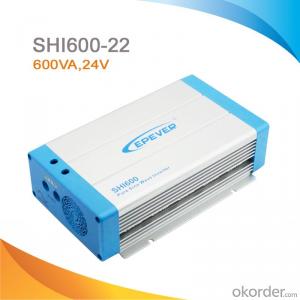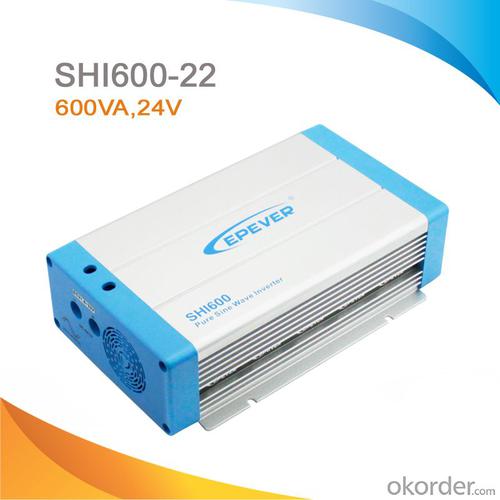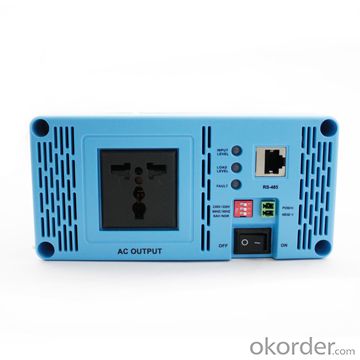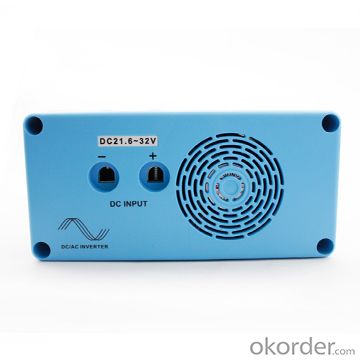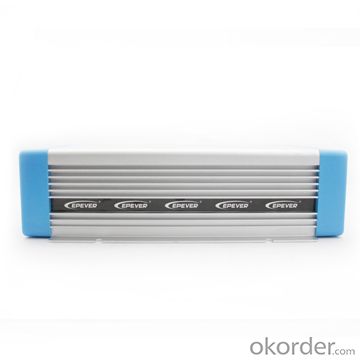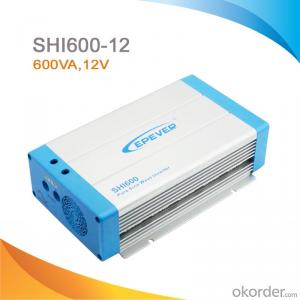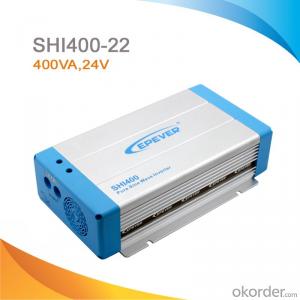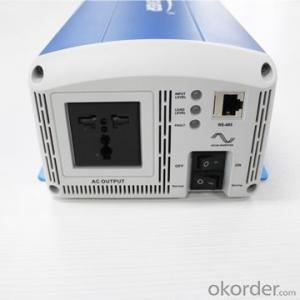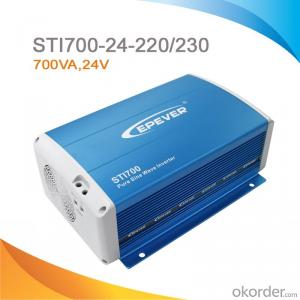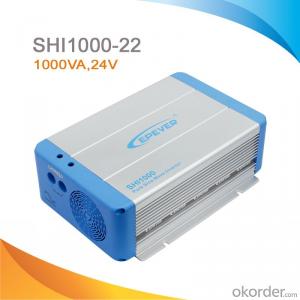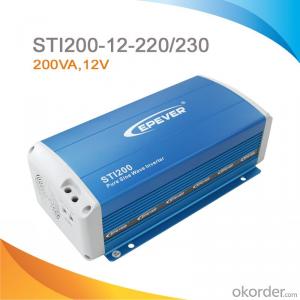500 Kw Solar Inverter - High Efficiency Off-Grid Pure Sine Wave Power Inverter 600W, 24V-220V/230V, SHI600-22
- Loading Port:
- China Main Port
- Payment Terms:
- TT or LC
- Min Order Qty:
- -
- Supply Capability:
- -
OKorder Service Pledge
OKorder Financial Service
You Might Also Like
Description
SHI series is a pure sine wave inverter which can convert 12/24/48Vdc to 220/230Vac 50/60Hz based on full digital and intelligent design. It features high reliability, high efficiency, concise outline, small volume, easy installation and operation. The inverter can be applied in many fields, such as household appliances, electric tools and industrial devices etc, especially for solar photovoltaic power system.
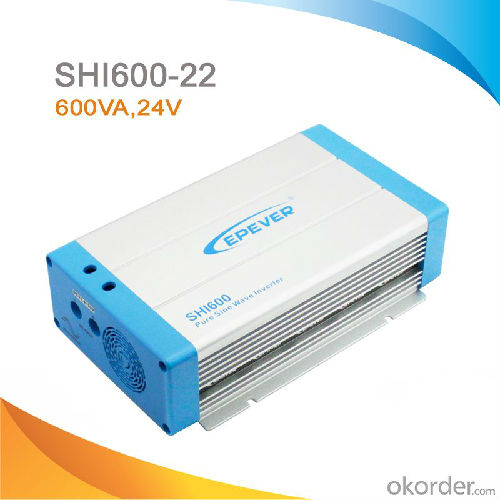
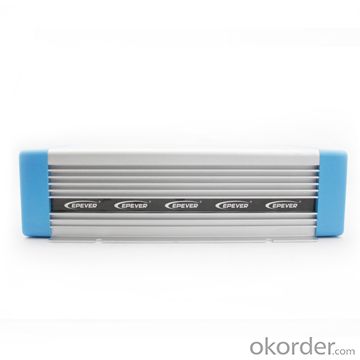
Features:
·Adoption of advanced SPWM technology, pure sine wave output
·Dynamic current loop control technology to ensure inverter reliable operation
·Wide DC input voltage range
·The output voltage and frequency can be switched
·Low output harmonic distortion(THD≤3%)
·LED indicators for input voltage range, load power range, normal output & failure state
·Optional energy saving mode
·Wide working temperature range (industrial level)
Protections:
·Output short circuit protection
·Overload protection
·Input low voltage protection
·Input over voltage protection
·Overheating protection
·Inverter abnormal protection
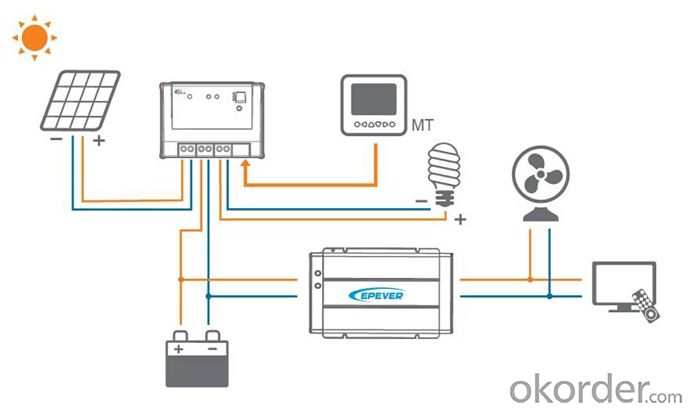
Specification:
Types | SHI600-12 | SHI600-22 |
Nominal Battery Voltage | 12V | 24V |
Input Voltage Range | 10.8~16Vdc | 21.6~32Vdc |
No Load Current | ≤0.7A | ≤0.45A |
Output Wave | Pure Sine Wave | |
Output Voltage | 220Vac±3% / 230Vac±10% | |
Continuous Power | 600W | |
Power 10 sec | 900W | |
Power 1.5 sec | 1200W | |
Surge Power | 1350W | |
Frequency | 50/60Hz±0.2% | |
Distortion THD | ≤ 3% (resistive load) | |
Efficiency at Rated Power | ≥91% | ≥92% |
Max. Efficiency | ≥93% | ≥94% |
Terminal | 25mm2 | |
Dimensions | 295×186×82mm | |
Installation | 150×178mm | |
Hole Size | Φ6mm | |
Net Weight | 2.3kg | |
Working Temperature | -20℃~ +50℃ | |
Storage Temperature | -35℃~ +70℃ | |
Humidity | < 95% (N.C.) | |
Altitude | < 5000m(Derating to operate according to IEC62040 at a height exceeding 1000m) | |
Insulation Resistance | Between DC input terminals and metal case: ≥550MΩ; Between AC output terminals and metal case: ≥550MΩ. | |
Dielectric Strength | Between DC input terminals and metal case: Test voltage AC1500V, 1 minute Between AC output terminals and metal case: Test voltage AC1500V, 1 minute | |
FAQ
Q: Off Grid VS On Grid Panels, what's the difference?
The differences between both panels are related to the system where they are going to be installed.
On-grid installations, as the name said, are thought to feed the produced energy into the grid and for that it is important to have the biggest voltage that it is allowed (1000VDC in Europe, 600 VDC in USA). For a defined power, more voltage means less current (P=V*I) and less losses.
In off-grid installations it is different because you must storage the energy into batteries. Batteries usually work at 12, 24 or 48 VDC and off-grid photovoltaic modules work at the maximum power point (mpp) near this voltage (see the datasheets). So the controller that charges the batteries works also near the batteries voltage.
Your limiting factor here is going to be this controller. You have to see what is the maximum voltage and the maximum current that it can work with, upstream (photovoltaic modules) and downstream (batteries and inverter). Then you have to dimension your PV array (Voltage and Current).
- Q: What are the safety measures to consider when installing a solar inverter?
- When installing a solar inverter, several safety measures should be considered. Firstly, it is important to ensure that the installation is performed by a qualified and certified professional to minimize the risk of accidents. It is crucial to follow the manufacturer's guidelines and recommendations during the installation process. Additionally, it is essential to disconnect the solar inverter from the power source before starting any installation or maintenance work to prevent electrocution. Proper grounding and wiring techniques should be followed to reduce the risk of electric shock or fire hazards. Adequate ventilation and temperature control should be provided to prevent overheating of the inverter. Regular inspections and maintenance checks should be conducted to ensure the inverter's safe and efficient operation. Overall, prioritizing safety measures during the installation process is crucial to protect both the installer and the system's end-users.
- Q: How does a solar inverter handle variations in grid frequency?
- A solar inverter handles variations in grid frequency by continuously monitoring the frequency of the grid and adjusting its output accordingly. It is designed to synchronize with the grid frequency and maintain a stable and consistent output, even when the grid frequency fluctuates. This helps to ensure that the solar energy generated is efficiently fed into the grid, without causing any disruption or damage to the inverter or the grid itself.
- Q: Can a solar inverter be integrated with a smart home system?
- Yes, a solar inverter can be integrated with a smart home system. By connecting the solar inverter to the smart home system, users can monitor and control their solar energy production and consumption remotely. This integration allows for better energy management, optimizing the use of solar power, and potentially saving on electricity bills.
- Q: What is the role of a transformer in a solar inverter?
- The role of a transformer in a solar inverter is to convert the direct current (DC) electricity generated by the solar panels into alternating current (AC) electricity suitable for use in homes and businesses. The transformer helps to step up or step down the voltage levels, ensuring efficient and safe transmission of electricity from the solar panels to the electrical grid or connected loads.
- Q: How does a solar inverter protect against overvoltage?
- A solar inverter protects against overvoltage by continuously monitoring the voltage levels of the solar panels. If the voltage exceeds a certain threshold, the inverter automatically reduces the power output or disconnects from the grid to prevent damage to the system and ensure the safety of the electrical components.
- Q: How does a solar inverter handle power export limitations imposed by the grid?
- A solar inverter handles power export limitations imposed by the grid through a process called power factor control. The inverter continuously monitors the grid's voltage and frequency, adjusting its power output accordingly. If the grid imposes limitations on power export, the inverter reduces its output to stay within the allowed limits. This ensures that the solar system operates in compliance with the grid regulations and prevents any excess power from flowing back into the grid.
- Q: What is the role of a solar inverter in a solar-powered remote monitoring system?
- The role of a solar inverter in a solar-powered remote monitoring system is to convert the direct current (DC) electricity generated by the solar panels into alternating current (AC) electricity that can be used to power the monitoring system. It also ensures that the electricity generated matches the requirements of the monitoring equipment, regulates the voltage, and assists in efficient power transmission and distribution.
- Q: Can a solar inverter be used with a solar-powered electric vehicle charging infrastructure?
- Yes, a solar inverter can be used with a solar-powered electric vehicle charging infrastructure. The solar inverter converts the direct current (DC) produced by the solar panels into alternating current (AC) which is compatible with the electric vehicle charging system. This allows for the utilization of solar energy to power the charging infrastructure for electric vehicles.
- Q: How does a solar inverter communicate with other system components?
- A solar inverter communicates with other system components through wired or wireless connections. It exchanges data and instructions with solar panels, batteries, smart meters, and monitoring systems using protocols such as Modbus, CAN bus, or Wi-Fi. This communication enables real-time monitoring, power optimization, grid interaction, and system management for efficient and effective solar energy utilization.
- Q: Can a solar inverter be used with a solar-powered electric vehicle charging station?
- Yes, a solar inverter can be used with a solar-powered electric vehicle charging station. The solar inverter is responsible for converting the direct current (DC) electricity generated by the solar panels into alternating current (AC) electricity that can be used to charge electric vehicles. This allows the solar-powered charging station to efficiently utilize the solar energy and provide clean and sustainable charging for electric vehicles.
Send your message to us
500 Kw Solar Inverter - High Efficiency Off-Grid Pure Sine Wave Power Inverter 600W, 24V-220V/230V, SHI600-22
- Loading Port:
- China Main Port
- Payment Terms:
- TT or LC
- Min Order Qty:
- -
- Supply Capability:
- -
OKorder Service Pledge
OKorder Financial Service
Similar products
Hot products
Hot Searches
Related keywords
